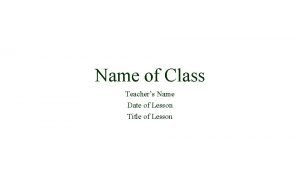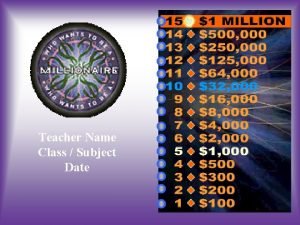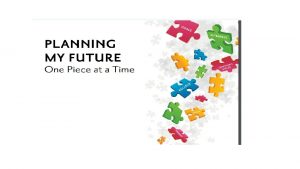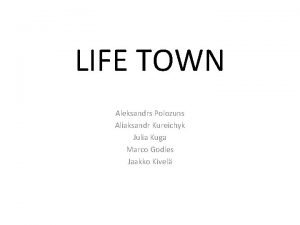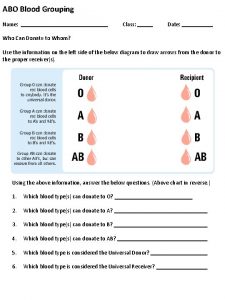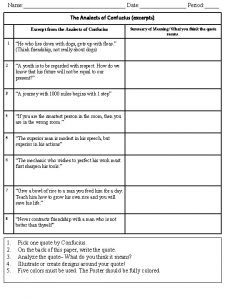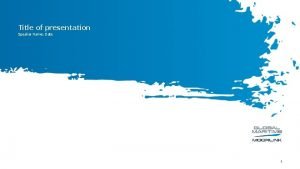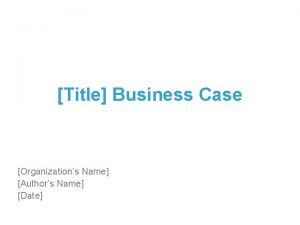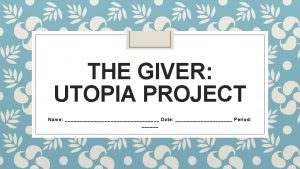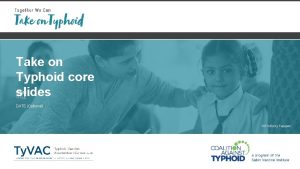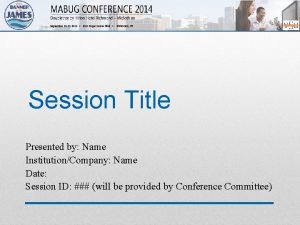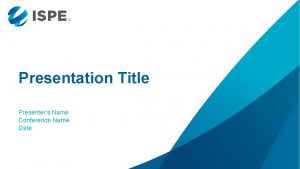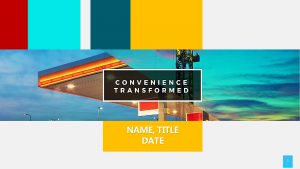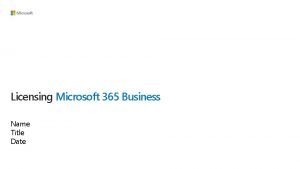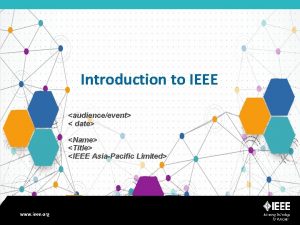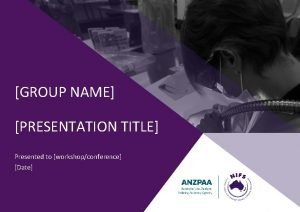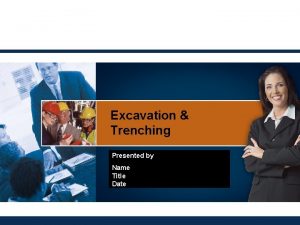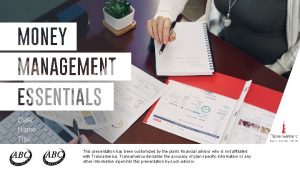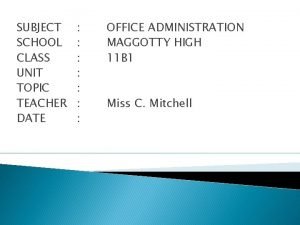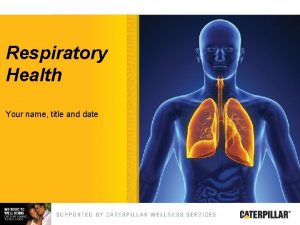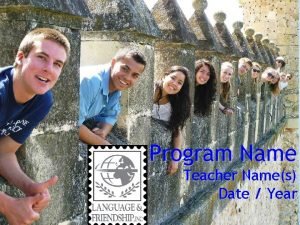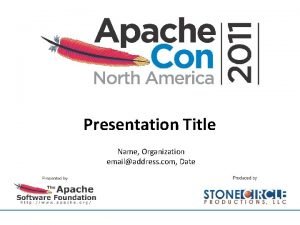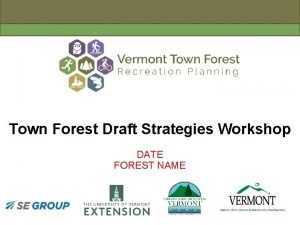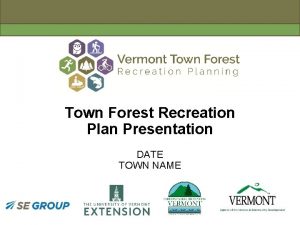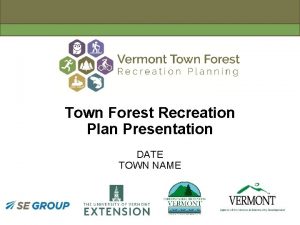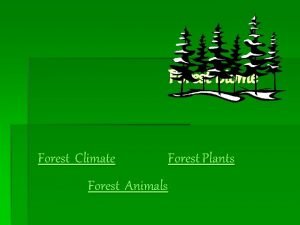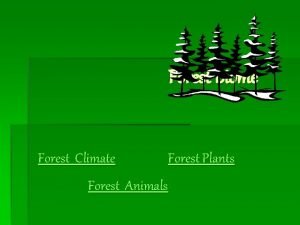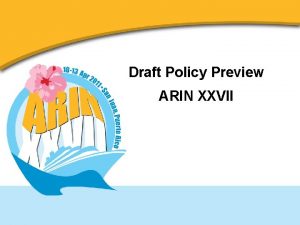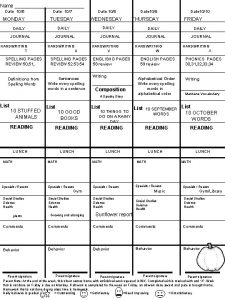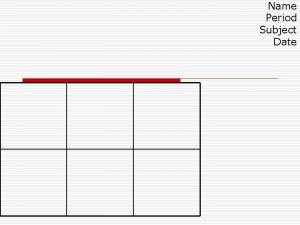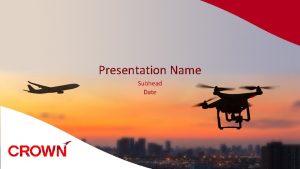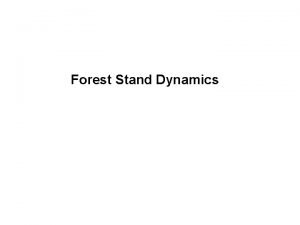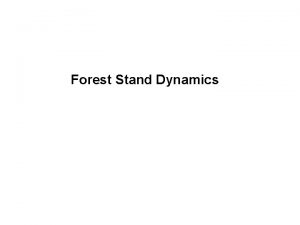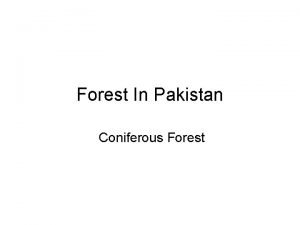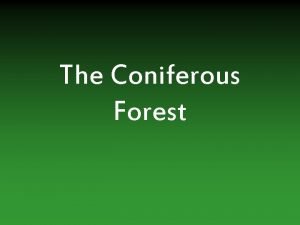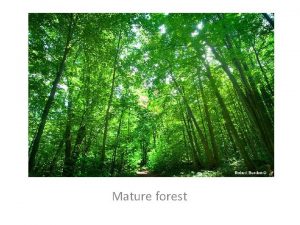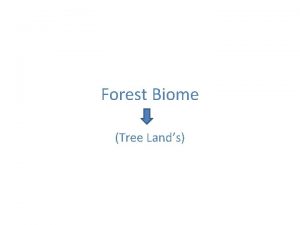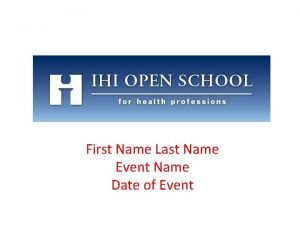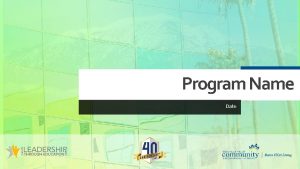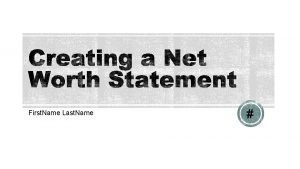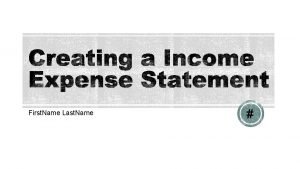Town Forest Draft Strategies Workshop DATE FOREST NAME




























- Slides: 28

Town Forest Draft Strategies Workshop DATE FOREST NAME

Agenda

Agenda What are we going to do tonight? 1. Presentation (7: 00 -8: 00 PM) • • 2. Project Overview and Progress Draft Vision Framework Draft Strategies Large Group Questions/Discussion Open House Workshop (8: 00 -8: 30 PM) • • • Priority Boards Write-In Map Facilitator Conversations Comment Box No closing presentation—leave when you’re done!

Project Overview

Project Purpose and Scope Empowering Communities to Move Forward with Confidence in their Town Forest Three Key Areas: 1. Developing a compelling and inspiring vision to help guide the future management of each of the ten selected town forests 2. Developing discrete, clear and actionoriented strategies for improvement of recreation and stewardship that achieves the vision 3. Fostering implementation with guidance, best practices and tools for implementation in the project toolkit

Project Deliverables Action Plans With Discrete, Clear and Implementable Strategies for Improvement of Recreation • Action Plans will identify: • Project description • Action responsibility • Timing (immediate, short, medium, long-term) • Partners involved • Action or planning dependencies • Available support resources • Toolkit resources • Funding and grant opportunities • Magnitude of costs ($-$$-$$$$) Photo Courtesy of John Atkinson, Mad River Riders Everything you need to go after grants to implement these projects!

Project Deliverables Bubble Diagram Maps—Planning Before Design

Our Recreation Planning Toolkit Additional resources and information to complete and implement your plan Some of the resources we have access to: • Promotional material and public meeting templates • Guidance and best practices on meeting promotion and facilitation • Community survey questions • Survey interpretation and vision crafting guidance • Resource protection guidance Parking • Case studies of each of the 10 towns and your plans Toolkit • Personal narratives from the 10 towns • Recreational improvements strategy database • Index of standard recreational improvement costs • How-to webinars Management Zones Toolkit Grant Writing Best Practices Sustainable Trail Standards Pause Places Toolkit Volunteer Project Designs Considerations Trail Counting Forms Vtrans Signage Program Model Process for New Trails Conservation Best Practices

Project Deliverables An Implementation Toolkit with Best Practices for Design

Natural Resources Guidelines • Section about each natural community in the forest: vernal pools, floodplain forests, wetlands, deer wintering areas, etc. • For each, there’s background information, explanation of its importance, general management guidelines, regulatory issues, links to additional resources and guidelines, and a matrix of compatible activities.

Phase 1: Visioning Public Visioning Workshop Steering Committee Visioning Community Survey Draft Vision Framework for Town Forest Phase 2: Strategies Development Environmental Considerations & Site Constraints Develop Range of Strategies to Achieve Vision Strategies Workshop: You Are Here Phase 3: Plan Development Legend • Review Draft Vision • Select & Prioritize Strategies Draft Action Plan Community Input Project Toolkit & Document Templates Plan Presentation Workshop Phase 4: Implementation Construction & Design Standards Final Plan Document Management Best Practices Implementation Coaching Funding & Support Resources

Project Progress Community Visioning & Draft Strategies • Forest Walk • Identifying areas of ecological and recreational importance in the forest • Steering Committee Meetings • Analysis of Strengths, Weaknesses, Opportunities, and Threats to the forest • Public Workshop Photo of Public Workshop • DATE • ___ attendees • Questions about a vision, natural resources, activities, programs, and events in the forest • Survey • ___ responses • Available both online and hard copy • Same questions as the public workshop This information was taken into account in developing natural resource guidelines, vision framework, and strategies for the forest

Vision Framework

Vision Framework Turning the community’s ideas into a framework for the future • Community’s ideal conditions for the forest • Encompasses a variety of local perspectives • Allows for more complexity than a 1 -2 sentence vision statement • Includes: 1. 2. A discussion of management balance in the forest A list of key attributes that describe the community’s desired character for the forest • This framework covers all forest uses (not just recreation)

Existing Experiences What word or phrase best describes your EXISTING experience with our town forest? Wordcloud from survey results

Future Experiences What word or phrase best describes your DESIRED FUTURE experience with our town forest? Wordcloud from survey results

Management Balance Where should the management focus fall for the Town Forest in your community? The Marshfield community expressed that Natural Resources & Habitat, Education & Demonstration Projects, andfocus Recreation are more important Management summary for uses in the management of the forestwritten than Timber & Forest Products. vision framework Both survey respondents and workshop participants felt that Natural Resources & Habitat were most important. Public Workshop results Workshop Participants Online Survey results Survey Respondents

Key Attributes Words or short phrases that communicate what the community believes are the ideal conditions for the forest - the same or different from how things looks today • Multi-dimensional (haying, sugaring, habitat, conservation, recreation, etc. ) • Peaceful and quiet • Sustainable and well-maintained trail system • • Preserve and interpret cultural and historical resources • Solitude, rest, and rejuvenation • Opportunities for learning about stewardship, history and Protection of wildlife habitat • Community utilized and maintained • Protection of vernal pools, wetlands, and other water resources • Well managed with the Forest Committee, Select Board, and input from the community • Inclusive of a variety of users and community perspectives • Beautiful views • Engaged and appreciated volunteer group • Year-round recreation (snowshoeing, biking, hiking, cross country skiing) • Well-located and accessible • A piece of a larger conserved forest block • Remarkable biodiversity • Connectivity to other forested areas • Maintain healthy balance between stewardship and human uses • Low key and low intensity use • Place to appreciate the natural world • Multi-generational Key attributes from the forest Vision Framework

Issues, Needs, and Ideas Identifying the current condition of the forest and opportunities for improving and achieving the key attributes • Timber management impacts • Some trails, particularly old logging roads, have poor drainage • Balancing uses • Potential for overuse • Potential conflicts with private landowners Issues, needs, and ideas identified in • Confusion around forest vs. private land boundary Vision Framework • Drainage and condition of Thompson Road • Lack of data on forest use • Limited accessibility for elders and persons with disabilities • Sap lines through the forest • In need of additional funding sources • Need for collaborative community dialogue around forest use

Strategies

Trails Strategies Relative Cost ($-$$-$$$$$$$) Toolkit & Support Resources Continue to study existing trails, especially those following former logging roads, and evaluate for potential ecological harm and mitigate the site through necessary means. Decommission or reroute trails as needed. $ -Trail assessment forms -Natural Resource Guidance Toolkit -Sustainable Trail Standards Improve the existing trail system with strategic connections to enhance experiences for all user groups. Ensure system includes a mix of traditional footpaths and "bike-optimized" multi -use natural surface trails to provide desired experiences. Consider rebuild or replacement of Selected strategies existing logging roads or unsustainable trails to from Vision Framework improve drainage, limit erosion, and limit trail density. New connections could include an apple picking trail (that leads to the orchard) or connections for an interpretive/history trail. $$ -Sustainable Trail Standards $$$ -Sustainable Trail Standards -Interpretation Guidance Toolkit Strategy or Action Description 2. Trails Existing trail conditions assessment and review New trail connections New accessible path or interpretive trail Build a graded, accessible path for all ages and abilities to enjoy the forest. Such paths are typically short (~1 mile) and provide ample opportunities for rest and education with stations or stops next to points of natural or cultural interest. Coordinate with educational programming. Trail markers and signage Continue to add signage in the forest for wayfinding, information, and trail etiquette. Ensure it communicates town ownership and/or conservation commission management. $$ -Trail Markers and Wayfinding Toolkit -Interpretation Guidance Toolkit Marshfield Trails Collaborative Continue to convene mountain bikers, hikers, and other user groups for an on-going dialogue around trails and to establish a framework for collaboration in the future. $ -Volunteer Development and Recruitment Toolkit

Other Facilities and Structures Strategies Strategy or Action Description Relative Cost Toolkit & Support ($-$$-$$$- Resources $$$$) 3. Other Facilities and Structures Pause Places Develop a series of "Pause Places" or "minidestinations' along the trail system. These may be a rest stop, an informational stop, or both. All pause places should include a bench or appropriate rocks/boulders for seating and should capitalize on locations with the potential for views, sunsets, wildlife observation, rest, and rejuvenation. Opportunities for natural and historical interpretation should also be explored. $$ - Pause Places Toolkit -Bench Volunteer Designs '-Interpretation Guidance Toolkit Restore Apple Orchard Restore trail to apple orchard to open up access. Improve the orchard itself to become a community resource. $$ -Sustainable Trail Standards Develop an outdoor classroom Create a small gathering space with picnic tables, benches, earthen mounds etc. for schools and other groups. $$ - Sustainable Facility Standards -Natural Resource Guidance Toolkit

Education & Programs Strategies Strategy or Action Description Relative Cost ($-$$$$$) Toolkit & Support Resources 4. Education & Programs Educational Programs/Outdoor Program Continue holding educational programs in the forest about the history and ecology of the forest. $ -Programming Partnerships Toolkit Ecology tours Continue offering ecology tours (birdwatching, plant identification, etc. ) for children and adults. $ -Programming Partnerships Toolkit Land management education Create awareness and education programs around the land management of the forest. Consider interpretive signage. $ -Interpretation Guidance Toolkit Interpretive signage Develop interpretive signage that support educational programs and self-guided learning. Coordinate with development of the pause places $$ -Interpretation Guidance Toolkit Species identification lists Bird, plant and mammal species identification checklists could be developed and made available at the trailhead kiosk. Should also be utilized in education experiences. $ -Programming Partnerships Toolkit

Maps, Outreach, & Promotion Strategies Strategy or Action Description Relative Cost Toolkit & Support ($-$$-$$$ Resources -$$$$) 6. Maps, Outreach, & Promotion -Volunteer Development and Recruitment Toolkit Community Engagement Continue to engage the community about the forest. Identify community members who have a useful skill to offer. $ Measure forest use Use trail counters or volunteer trail counts to gather data about the number of users of the forest. $/$$ - Volunteer Trail Counting Forms Improve maps of the forest Create maps that show all trails in the forest and make these maps readily available both online and in print. $-$$ -Mapping and Promotion Toolkit

Administrative Actions Strategies Strategy or Action Description Relative Cost Toolkit & Support ($-$$-$$$- Resources $$$$) 7. Administrative Actions Remove invasive plants that are growing in the forest. $ -Natural Resource Guidance Toolkit Management zones Expand use of management zones in town forest management plan to consider and plan for all uses. Designate areas more suitable for wildlife habitat, hunting, or mountain biking, for example. $ -Management Zones Toolkit Partner with local groups interested in recreation, conservation, and programming. Partner with the Conservation Commission, Twinfield School, and other local conservation and recreation groups such as VAST, Riders in Plainfield-Marshfield, and Friends of the Winooski. $ -Programming Partnerships Toolkit Adopt formal process for proposing and reviewing new trails and facilities Process will include ecological concerns and will provide all stakeholders and user groups an opportunity to propose new trails and facilities. $ -Model Proposal Process -Natural Resource Guidance Toolkit

Questions?

We Need Your Input! Please share your thoughts on these strategies and how they should be prioritized! • • • Priority Boards Write-In Map Facilitator Conversations Comment Box No closing presentation—leave when you’re done! Please leave your email on the sign-in sheet to receive meeting notices and project updates!

Thank You!!!!!
 Relation between actual draft and mechanical draft
Relation between actual draft and mechanical draft Sin values
Sin values Name date class teacher
Name date class teacher Name class date
Name class date Name teachers name class date
Name teachers name class date Record date dividends
Record date dividends Ex dividend record date
Ex dividend record date Kuga town
Kuga town Name
Name Name class date
Name class date By name title date
By name title date Name date period
Name date period By name title date
By name title date Name title date
Name title date The giver map project
The giver map project By name title date
By name title date Session title examples
Session title examples Title of presenter
Title of presenter Name title date
Name title date By name title date
By name title date By name title date
By name title date By name title date
By name title date By name title date
By name title date By name title
By name title By name title date
By name title date Name class teacher date
Name class teacher date Name title date
Name title date Name class teacher date
Name class teacher date Emailaddress.com
Emailaddress.com


